The project farm was the largest employer of evacuees at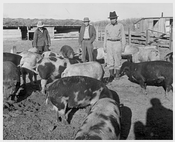 the center. Vegetables were produced in
abundance at the farm as well as alfalfa, corn and sorghum for
the 1,000 head of hogs, 800 head of cattle and calves, and 16,000
chicken which the camp owned. The farm embraces 4,095 acres on
the XY Ranch and 5,688 acres on the Koen Ranch. Of this acreage
almost 6,000 acres was under irrigation.
the center. Vegetables were produced in
abundance at the farm as well as alfalfa, corn and sorghum for
the 1,000 head of hogs, 800 head of cattle and calves, and 16,000
chicken which the camp owned. The farm embraces 4,095 acres on
the XY Ranch and 5,688 acres on the Koen Ranch. Of this acreage
almost 6,000 acres was under irrigation.
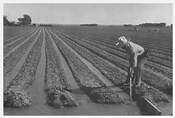 The Japanese were able to grow many
crops in the area which had previously never been grown. Such
crops included head-lettuce, celery, spinach, lima beans, and
onions. Many of the local farmers had predicted that the Japanese
would not be able to raise enough food to self-sustain the camp.
Not only did the Japanese produce enough too feed
The Japanese were able to grow many
crops in the area which had previously never been grown. Such
crops included head-lettuce, celery, spinach, lima beans, and
onions. Many of the local farmers had predicted that the Japanese
would not be able to raise enough food to self-sustain the camp.
Not only did the Japanese produce enough too feed 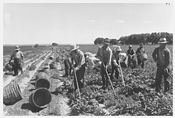 Amache,
but sixteen railroad cars of vegetables were shipped out of Colorado
to other centers (Holsinger
1960: 81). "Local farmers were so impressed by the horticultural
feats performed at the Amache farm and exhibited each fall after
harvest at a special camp bazaar that many offered to go into
partnership with the evacuee farmers" (Lurie
1990: 74-75). The crops harvested at the Amache farm in 1943
was valued at $190,00 with the cost of production being less
than $50,000 (WRA
1944: 27).
Amache,
but sixteen railroad cars of vegetables were shipped out of Colorado
to other centers (Holsinger
1960: 81). "Local farmers were so impressed by the horticultural
feats performed at the Amache farm and exhibited each fall after
harvest at a special camp bazaar that many offered to go into
partnership with the evacuee farmers" (Lurie
1990: 74-75). The crops harvested at the Amache farm in 1943
was valued at $190,00 with the cost of production being less
than $50,000 (WRA
1944: 27).
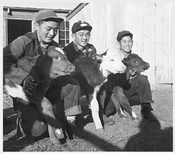 Several times Amache laborers have alleviated
severe crisis in the Colorado agriculture industry that resulted
from labor shortages. Shortly after the arrival of the evacuees
sugar beet farmers
asked for the help of evacuees in order to help harvest the crop.
The evacuees were able to harvest 65,300 tons of sugar beets
which was important in light of the relative scarcity of sugar
during the war (Schwartz
1979: 26).
Several times Amache laborers have alleviated
severe crisis in the Colorado agriculture industry that resulted
from labor shortages. Shortly after the arrival of the evacuees
sugar beet farmers
asked for the help of evacuees in order to help harvest the crop.
The evacuees were able to harvest 65,300 tons of sugar beets
which was important in light of the relative scarcity of sugar
during the war (Schwartz
1979: 26).
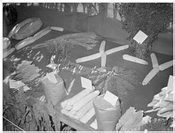
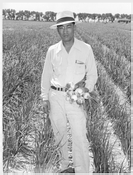
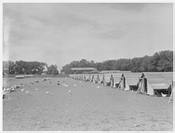
![]()
Education

Return to Amache

 the center. Vegetables were produced in
abundance at the farm as well as alfalfa, corn and sorghum for
the 1,000 head of hogs, 800 head of cattle and calves, and 16,000
chicken which the camp owned. The farm embraces 4,095 acres on
the XY Ranch and 5,688 acres on the Koen Ranch. Of this acreage
almost 6,000 acres was under irrigation.
the center. Vegetables were produced in
abundance at the farm as well as alfalfa, corn and sorghum for
the 1,000 head of hogs, 800 head of cattle and calves, and 16,000
chicken which the camp owned. The farm embraces 4,095 acres on
the XY Ranch and 5,688 acres on the Koen Ranch. Of this acreage
almost 6,000 acres was under irrigation. The Japanese were able to grow many
crops in the area which had previously never been grown. Such
crops included head-lettuce, celery, spinach, lima beans, and
onions. Many of the local farmers had predicted that the Japanese
would not be able to raise enough food to self-sustain the camp.
Not only did the Japanese produce enough too feed
The Japanese were able to grow many
crops in the area which had previously never been grown. Such
crops included head-lettuce, celery, spinach, lima beans, and
onions. Many of the local farmers had predicted that the Japanese
would not be able to raise enough food to self-sustain the camp.
Not only did the Japanese produce enough too feed  Amache,
but sixteen railroad cars of vegetables were shipped out of Colorado
to other centers (Holsinger
1960: 81). "Local farmers were so impressed by the horticultural
feats performed at the Amache farm and exhibited each fall after
harvest at a special camp bazaar that many offered to go into
partnership with the evacuee farmers" (Lurie
1990: 74-75). The crops harvested at the Amache farm in 1943
was valued at $190,00 with the cost of production being less
than $50,000 (WRA
1944: 27).
Amache,
but sixteen railroad cars of vegetables were shipped out of Colorado
to other centers (Holsinger
1960: 81). "Local farmers were so impressed by the horticultural
feats performed at the Amache farm and exhibited each fall after
harvest at a special camp bazaar that many offered to go into
partnership with the evacuee farmers" (Lurie
1990: 74-75). The crops harvested at the Amache farm in 1943
was valued at $190,00 with the cost of production being less
than $50,000 (WRA
1944: 27). Several times Amache laborers have alleviated
severe crisis in the Colorado agriculture industry that resulted
from labor shortages. Shortly after the arrival of the evacuees
sugar beet farmers
asked for the help of evacuees in order to help harvest the crop.
The evacuees were able to harvest 65,300 tons of sugar beets
which was important in light of the relative scarcity of sugar
during the war (Schwartz
1979: 26).
Several times Amache laborers have alleviated
severe crisis in the Colorado agriculture industry that resulted
from labor shortages. Shortly after the arrival of the evacuees
sugar beet farmers
asked for the help of evacuees in order to help harvest the crop.
The evacuees were able to harvest 65,300 tons of sugar beets
which was important in light of the relative scarcity of sugar
during the war (Schwartz
1979: 26).


